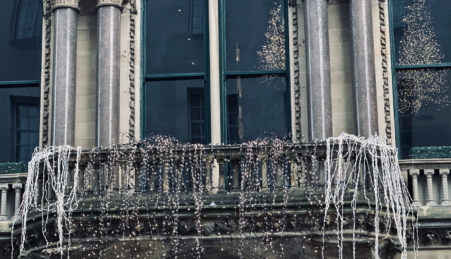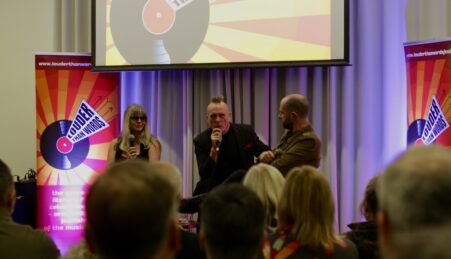By Campbell Bishop
Photography: Sean O’Mahoney
Manchester is a perfect mix of old and new. A city characterised equally by its modern complexes as well as its modest conservation. Here are the must-visit sites dotted around the city centre, that capture Manchester’s rich history.
1. The Roman Fort at Castlefield

The Romans founded Manchester – originally named Mamucium – in AD 79, and this reconstructed fort perfectly illustrates the city’s ancient origins. The settlement was founded partly because of Manchester’s defensive value – the rivers Irwell and Medlock gave substantial protection. It is now a dreamy, peaceful part of the city. There is never an excess of visitors – and, with a little imagination, you can picture yourself strolling along the battlements of the ancient world.
2. Manchester Cathedral

There has been a church on the site of the present cathedral since 1215. The current structure – the result of repeated re-modifications – dates back to 1421 and has a medieval appearance. This church has been central to city life for centuries, but it was granted cathedral status as late as 1847 at a time when Manchester’s population was expanding rapidly through industrialisation. In 1940, the cathedral suffered significant bomb damage during the blitz, and a modernist stained glass window, illustrating a raging inferno, commemorates this. In recent years, the church has been one of Manchester’s more original music venues with both Elbow and The Fall playing here.
3. Chetham’s Library

Also dating back to 1421, this is the oldest complete building in the city. The library was initially connected to the nearby church and housed the local clergy, also serving as a college. In 1595, Dr John Dee – an agent of the occult, inspiration for Shakespeare, and certainly somebody worth googling – became college warden. You can still see a mark on a table where the doctor is believed to have conjured up the devil. A less controversial character, Sir Humphrey Chetham founded a library here later, in 1653. The building, purely medieval in appearance, is almost completely hidden by the surrounding School of Music and this only adds to the sense of mystery. A host of historical figures have graced the library down the generations. Daniel Defoe, Benjamin Franklin, Benjamin Disraeli, Winston Churchill and, perhaps most famously, Karl Marx and Friedrich Engels have all studied here. The latter two famously conducted much of their research into social conditions in the city. In time, this would lead to the Communist Manifesto, and few texts have had such a giant impact on world history.
4. Liverpool Road Station

Down the road from the Roman Fort stands the oldest surviving railway station in the world. No longer a working station, it is owned by the excellent Museum of Science and Industry. The Duke of Wellington officially opened the station in September 1830, and the property is notable for its inconspicuous design features; nobody really knew how a railway station should look back then, so this building takes on the appearance of a colourful row of Georgian style terraces. A plaque denotes the site’s historic importance but there is little else to illustrate its international significance. It is all very understated in this rather sleepy segment of the city.
5. The Free Trade Hall

This is a grand piece of mid-Victorian architecture in the Italian Renaissance style. It is, quite possibly, the only major public building in the country to be named after an economic principle. Free Trade was considered essential to Manchester’s cotton industry. Only the frontage remains, the rest having been swallowed up by a luxury hotel, but, thankfully, what survives is majestic in its detail. Originally a venue for public speeches, as well as the home of the Hallé Orchestra, the hall has hosted many distinguished orators over the years. Charles Dickens, Winston Churchill and U.S. President Woodrow Wilson are just a few examples. After the Second World War, and several direct hits on the site from German bombers, the Hall had a new lease of life as a popular music venue. It was here that Dylan was heckled ruthlessly for going electric – the infamous ‘Judas’ incident – and where the Sex Pistols played to a number of locals who, remarkably, went on to form successful bands of their own – The Smiths, Joy Division, and The Fall being three such examples.
6. Manchester Town Hall

This is the jewel in Manchester’s crown. Opening in 1877, this commanding seat of local government symbolised all the wealth and power of the city. It may be hard to believe now, but Manchester was once the richest city in the world, and staring up at the front of the town hall, in all its gothic splendour, is a reminder of such prestige. It was all built on cotton, and if you look up at the tip of the clock tower, you will see a golden cotton bud glorifying the connection. Inside, the Great Hall houses twelve stunning paintings by Victorian artist Ford Madox Brown depicting the story of Manchester; this is where it all comes together. In later years, the town hall has welcomed various film crews. The building’s interior bears close resemblance to the Houses of Parliament, so it has featured in the recent Sherlock Holmes movies and The Iron Lady, among others. If you hope to experience the town hall’s many treasures, as well as its unrivalled café, you had better be quick – it closes on January 15th for a massive six-year refurbishment project.
7. Anita Street Terraced Houses

In clear contrast, for those who prefer history from below, this block of humble terraces has played its own important role in the city’s history. Built in the late 19th Century, in the industrial district of Ancoats, this apparently modest housing represented a giant stride in the improvement of social conditions. This district was notorious as a sprawling slum and Engels was among its many critics. The slums and the factories have long since gone, but these pretty little properties are testament to gradual improvements in living conditions. For example, every home had its own toilet – quite an innovation you might think. Originally titled Sanitary Street, the name was changed in the 60s to satisfy the more mindful residents. Today, in an era of bland high-rise apartments, these tasteful terraces are still very much in demand.
8. John Rylands Library

Having opened on January 1st 1900, the suitably ambitious John Rylands library looked more like a new cathedral than a public library. The significance of the design choice soon becomes clear. Ryland was an enormously wealthy mill owner with a passion for religious texts. On his death in 1888, his wife Enriqueta commissioned this as a fitting legacy. Among its collections, the institution specialises in a wide range of religious texts from around the globe and from across the ages. The oldest piece of the New Testament in the world – dating back to 125 AD – is one such marvel, but many artefacts from both the Middle and Far East also abound. In fact, Rylands contains manuscripts in over 50 languages, housing one of the best collections of rare publications anywhere in the world.
9. The Midland Hotel

On opening in 1903, the Midland was one of the most luxurious hotels in the country. This is where Winston Churchill lived, in 1906, when he represented North-West Manchester; it is unlikely the local electorate would tolerate such extravagance today. In later years, this is where Churchill ordered 18 oysters and a bottle of champagne before a major speech. Even more famously, in 1904 Charles Rolls met Frederick Royce here as they proceeded to create their world famous motor company. According to folklore, one of the many such admirers of the hotel was Adolf Hitler who allegedly intended to make this his northern power base once the German invasion of Britain was complete. In brighter times, the Beatles were refused entry into the hotel restaurant because of their scruffy appearance. In recent years, the Midland has hosted both Labour and the Conservative parties during conference season; the hotel remains at the forefront of British political developments over a century after Churchill first stayed here.
10. Central Library

Manchester is clearly a city blessed with grand libraries. Opposite the Midland stands the neo-classical Central Library. Completed in 1934, at a time of economic depression, this was a proud civic achievement. Labour Prime Minister Ramsey MacDonald laid the foundation stone in 1930, and HM King George V gave the finished structure a grand opening four years later. At the time, this was the biggest library of its kind to be funded by a local authority. Inspired by Rome’s Pantheon, Central Library livens up St Peter’s Square with its detail and proportion, paving the way for what is now one of Manchester’s prettiest public spaces. This is one of the last examples of large-scale traditional architecture in the city and, given the Roman connection, brings us full-circle.















1 Comment
I love it! so interesting! I’ve never been to Anita Street Terraced Houses before.